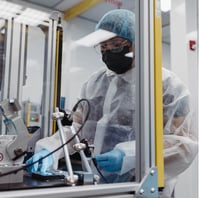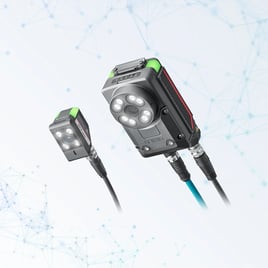At Micron Solutions, a contract manufacturer in Fitchburg, MA, we combine our workforce with our technology (“manomation”) to help scale projects. Our strategy allows us to compete effectively in the market, focusing on scalability, Design for Manufacturing (DFM), Design for Assembly (DFA), and Design for Automated Assembly (DFAA) principles. This whitepaper highlights the importance of early collaboration, cost transparency, and strategic planning in achieving optimal results.
The Manomation Approach
 Definition and Benefits
Definition and Benefits
Manomation, a combination of "man" and "automation," refers to the strategic integration of human skills with automated processes. This approach offers several advantages, including improved efficiency and productivity, enhanced quality control, greater flexibility and adaptability, and cost-effective scalability. This allows for the implementation of mistake-proofing or Poka-Yoke, reduced time to market as complete capital equipment are replaced with labor.
Implementing Manomation Medical Device Manufacturing
At Micron Solutions, we implement manomation by identifying processes suitable for automation, determining where human intervention is crucial for quality assurance, and developing a balanced workflow that optimizes both automated and manual processes.

The Role of Engineering
Effective scaling starts with engineering. Our engineering team designs for manufacturability and scalability, collaborates closely with production and quality control, and continuously optimizes processes based on data-driven insights.
Design Considerations
Design for Manufacturing (DFM)
DFM principles focus on optimizing the manufacturing process from the design stage. Key considerations include simplifying product design, standardizing components, and minimizing assembly steps.
Design for Assembly (DFA)
DFA aims to make the assembly process more efficient by reducing the number of parts, designing for easy handling and insertion, and minimizing the need for adjustments during assembly.
Design for Automated Assembly (DFAA)
DFAA extends DFA principles to accommodate automated assembly processes. This includes designing parts for easy robotic handling, incorporating features that facilitate automated alignment and insertion, and minimizing the need for human intervention in the assembly process.
Process Flow and Process FMEA
The manufacturing approach is designed and document with process flow mapping. Once the manufacturing steps are defined the potential failure modes are brainstormed for each step. Product design modifications or assembly steps are evaluated and effort is made to reduce the product quality risks.
Early Collaboration and Planning
Benefits of Early Collaboration
Early collaboration provides numerous benefits, including accurate ROI determination, risk identification and mitigation, and optimized resource allocation.
Planning for Success
Successful implementation involves mapping automated and manual processes, identifying special tooling requirements, and evaluating advanced manufacturing techniques such as two-component molding.
Scalability Considerations
Leveraging Automation for Scalability
To achieve scalability, we focus on implementing flexible automation systems, utilizing modular production lines, and real-time monitoring and adjustment.
Human Factor in Scaling 
Although it seems counterintuitive, the human element is crucial when it comes to scaling operations and getting the desired output. It’s one thing to scale quickly, it’s another to scale quickly and effectively. We utilize our team for quality control, fixing machines, and more to ensure that the output is something we’re proud of.
Cost Transparency and Project Management
Upfront Cost Sharing
At Micron Solutions, we believe in full transparency. We provide detailed cost breakdowns, including automation equipment costs, human resource requirements, and tooling and material expenses.
Project Mapping
Before project initiation, we create a comprehensive map outlining automated processes, manual quality control points, and potential scalability challenges and solutions. With this, we can mitigate risk and ensure our team is on the same page before getting started.
Departmental Focus 
We make sure that each department has the necessary tools and resources. For example, Engineering is equipped with advanced CAD/CAM software and simulation tools. Production has access to state-of-the-art automation equipment and ergonomic workstations. Quality Control utilizes cutting-edge inspection technologies and data analytics tools.
Regulatory Compliance
GAMP (Good Automated Manufacturing Practice)
We adhere to GAMP guidelines to ensure validated automated systems, consistent product quality, and regulatory compliance.
Case Study: Wearable Drug Delivery Device
To illustrate the effectiveness of our manomation approach, let's examine how Micron Solutions quickly and effectively manufactured a drug delivery device project.
Project Overview
The client approached us with a design for an innovative wearable drug delivery device aimed at transforming the lives of patients with chronic conditions. The project involved manufacturing three key components with intricate geometries and multi-material requirements.
Challenges
- Complex, multi-dimensional shapes pushing the boundaries of traditional molding techniques.
- Need for seamless integration between components.
- Requirement for high precision and consistency in manufacturing.
- Tight budget and timeline constraints.
Our Approach
Leveraging our expertise in advanced 2-shot injection molding and manomation principles, we developed a comprehensive strategy to address these challenges:
- Advanced Manufacturing Techniques: We utilized our specialized 2-shot injection molding process, which allows for the simultaneous injection of two different materials into a single mold. This approach enabled us to create highly complex, multi-material parts with precision and efficiency.

- Automated Quality Control: We implemented an automated multiprocess manufacturing cell that included secondary processes such as printing, heat staking, and in-line optical inspection. This ensured consistent quality and minimized potential errors.
- Precision Engineering: Our team carefully calibrated and monitored the 2C mold systems to maintain tight tolerances, using rotary table and turn-and-flip systems for precise material alignment.
- Efficient Scaling: By consolidating multiple components into single, high-precision parts, we streamlined the production process, reducing lead times and labor costs while maintaining quality.
- Human Expertise: Our skilled workforce provided critical oversight, problem-solving, and quality assurance throughout the manufacturing process, complementing our automated systems.
Results
- Successfully manufactured three key components with intricate geometries and seamless integration.
- Achieved high precision and consistency in production, meeting stringent medical device industry standards.
- Reduced production time and costs compared to traditional assembly-based manufacturing methods.
- Delivered a high-quality product within the client's budget and timeline constraints.
- Enabled the client to bring their innovative wearable drug delivery device to market, improving patient care and quality of life.
This case study demonstrates how Micron Solutions’ manomation approach allowed us to take on and successfully scale a project that larger competitors turned a blind eye to after seeing the budget and size. By leveraging our specialized equipment, innovative processes, and skilled workforce, we were able to meet the complex requirements of the wearable drug delivery device while maintaining cost-effectiveness and efficiency.
Conclusion
By adopting a balanced approach of automation and human collaboration, Micron Solutions can effectively compete in the drug delivery device manufacturing market. This strategy, coupled with early collaboration, transparent cost sharing, and a focus on scalability, helps us best serve customers of all sizes.


